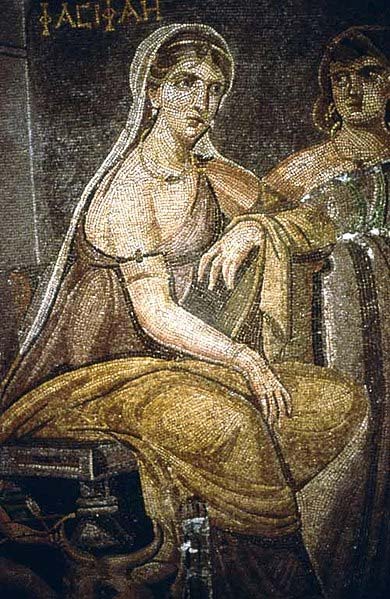
Pasiphae: Daughter of the Sun, Wife of a King, and Mother of the Minotaur
Pasiphae is a figure from Greek mythology. She is best-known as the wife of Minos, the legendary king of Crete, and the mother of the Minotaur. But Greek mythology has more to say about this interesting figure. Stories show she was a strange and spellbinding character.
Her Origins
The name Pasiphae may be literally translated as ‘light for all’. This name is apt, considering that she was the daughter of Helios, the god and personification of the Sun in Greek mythology. Her mother was Perseis, one of the Oceanids, i.e. the three thousand water nymphs who were the daughters of the Titans Oceanus and Tethys.

Pasiphae. (CC BY SA 4.0)
Pasiphae had several siblings. One of them was Circe, best known for her appearance in Homer’s Odyssey. She also had two brothers, Aeetes the king of Colchis and guardian of the Golden Fleece, and Perses. Whilst Aeetes and Perses were mortals, Pasiphae and Circe were both immortal.
- The Legendary Cretan Labyrinth Cave: Inspiration for the Story of King Minos and the Labyrinth of the Minotaur?
- Masks, Sex, Laughter, and Tears: The Exciting Evolution of Ancient Greek Theater
- The Descent of Ariadne: Minoan Queen of the Dead to Mistress of the Labyrinth?
Pasiphae and the Bull
Pasiphae was married to Minos, the son of Zeus and Europa and the stepson of Asterion, the king of Crete. When his stepfather died, Minos ascended the throne and Pasiphae became the queen of the island. In one myth, Minos had prayed to Poseidon in order to gain the throne of Crete. As a sign of his favor, Poseidon sent the king a snow-white bull, which became known as the Cretan Bull.
Minos was supposed to sacrifice the bull to the god. The king, however, refused to do so, and kept the beast alive instead. This displeased Poseidon, who punished the king by making Pasiphae fall in love with the bull.

Pasiphae and the bull. (Public Domain)
To satiate her lust, she sought the help of Daedalus, a master craftsman at the court of Crete. Daedalus created a hollow cow out of wood and wrapped it with real cowhide. She entered the construction and was brought out into a field. When the Cretan Bull mated with the wooden cow, it was also mating with Pasiphae. The result of this union between the bull and the Cretan queen was the infamous Minotaur, a monster that was half man and half bull.

Pasiphae, Daedalus, and the wooden cow. Roman fresco from the northern wall of the triclinium in the Casa dei Vettii (VI 15,1) in Pompeii. (Public Domain)
The tale of the Minotaur is one that many are already familiar with. In this myth, the Minotaur is slain by the Athenian hero Theseus, who was aided by Ariadne, one of Minos and Pasiphae’s daughters. The couple also had other children, including Deucalion, whose son Idomeneus led the Cretans in the Trojan War, and Androgeus, whose death in Athens led to the Athenians being obliged to send Minos 14 noble citizens (seven youths and seven maidens) as sacrificial victims for the Minotaur.

Pasiphaë and the Minotaur. Tondo of an Attic red-figure kylix, 340-320 BC. From Vulci. (Public Domain)
Magic and Minos
Minos also had children with other women and his unfaithfulness was known by his wife. As the queen was a sorceress, she was skilled in the use of magic. In an attempt to stop her husband from having affairs with other women, she concocted a potion that made Minos ejaculate snakes and scorpions instead of semen when he had sexual intercourse with anyone other than the queen.
- Taking the Bull by the Horns: The Perilous Minoan Practice of Bull-Leaping
- In Search of the Mythical King Minos, Did the Legendary Ruler Really Exist?
- Rice Goddesses - Earth Mothers who Influenced Heaven, Earth, and the Underworld
The king, however, was eventually cured by Procris, the daughter of Erechtheus, the king of Athens. As a reward for this deed, Procris was presented with Laelaps, a dog that never failed to catch its prey, and a javelin that always hit its target.

Gustave Doré's illustration of King Minos for Dante Alighieri's Inferno. (Public Domain)
Nothing is known about the fate of the queen, as her story ends after her children are mentioned. There is no more about her in the surviving Greek myths. However, some ancient authors recorded that there was a cult dedicated to Pasiphae.
Top Image: Pasiphae. Source: Public Domain
By Wu Mingren
References
Atsma, A. J., 2017. Minotauros. [Online]
Available at: http://www.theoi.com/Ther/Minotauros.html
Atsma, A. J., 2017. Pasiphae. [Online]
Available at: http://www.theoi.com/Titan/Pasiphae.html
Black, J. 2013. The Myth of the Minotaur. [Online]
Available at: http://www.ancient-origins.net/myths-legends-europe/myth-minotaur-00205
Encyclopedia Mythica, 1999. Pasiphaë. [Online]
Available at: https://pantheon.org/articles/p/pasiphae.html
Klimczak, N. 2016. T he Spellbinding Story of Circe, Goddess of Magic. [Online]
Available at: http://www.ancient-origins.net/myths-legends-europe/spellbinding-story-circe-goddess-magic-006787
Parkes, V. 2017. The Dramatic and Tragic Life of Ancient Greek Legend Daedalus. [Online]
Available at: http://www.ancient-origins.net/myths-legends/dramatic-and-tragic-life-ancient-greek-legend-daedalus-007336
Rejected Princesses, 2018. Pasiphae. [Online]
Available at: http://www.rejectedprincesses.com/princesses/pasiphae
The Editors of Encyclopaedia Britannica, 2017. Minotaur. [Online]
Available at: https://www.britannica.com/topic/Minotaur
www.greeklegendsandmyths.com, 2018. Queen Pasiphae in Greek mythology. [Online]
Available at: http://www.greeklegendsandmyths.com/pasiphae.html















